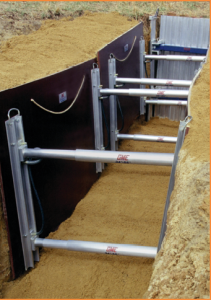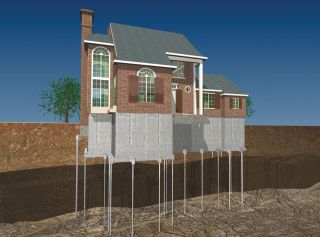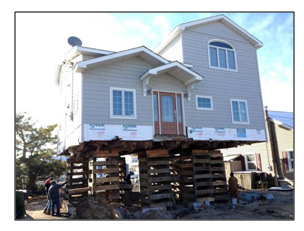Underpinning is a method used to increase the foundation depth. It is the process of modifying an existing foundation system by extending it to or into subsurface strata that is deeper and more stable than the near surface soil that supports the existing foundation system. This is done to provide vertical support that is not present in the existing design. Methods of underpinning include the construction of footings, stem walls, driven piling or drilled piers.
Many of the houses that forensic engineers and repair contractors are asked to evaluate were constructed with foundations that are inadequate for the conditions existing on site. Because of the lack of suitable land, homes are often built on marginal land that has insufficient bearing capacity to support the substantial weight of a structure. Also, where surface soils consist predominantly of expansive clays that shrink and swell as their moisture content changes. As a result, underpinning is required to extend the foundation support to depths that provide greater bearing capacity and are less affected by climate, soil conditions and homeowner’s actions. This underpinning provides the basis to lift the structure to a more acceptable elevation and provides vertical support to prevent the underpinned area from settling.
There are a number of different types of underpinning, depending on the circumstances.
● Mass Concrete underpinning is the most common method of underpinning. The ground below the existing building foundation is excavated in controlled stages (or pins). When strata suitable for bearing the weight of the building has been reached, the excavation is filled with concrete and left to cure before the next pin is excavated. Safe transfer of the building load to the new pin is achieved by ramming a dry sand cement packing mortar between new and old foundations.
● Beam and Base underpinning is a more technically advanced adaptation. A reinforced beam transfers the building load to mass concrete bases, the size and depth of which are dependent upon prevailing ground conditions and the applied loads of the building.
Mini-Piled underpinning is most suited to sites with variable ground conditions, restrictive access, or environmental pollution. It is used when foundation loads need to be transferred to stable soils at considerable depths.






 There are steps that you can take to prepare yourself and mitigate against damages. The first thing you can do is to know your risk. Next, you should create an emergency communication plan and build an emergency kit to ensure you and your family are prepared for a flood. As part of having a plan, we also encourage you to consider your coverage. A flood insurance policy can protect your home, property, or business from the financial damages of flooding. Most homeowner’s insurance do not cover damage from flooding.
In addition to these steps, there are also small flood proofing measures that you can take to help prevent, or minimize the impact of
There are steps that you can take to prepare yourself and mitigate against damages. The first thing you can do is to know your risk. Next, you should create an emergency communication plan and build an emergency kit to ensure you and your family are prepared for a flood. As part of having a plan, we also encourage you to consider your coverage. A flood insurance policy can protect your home, property, or business from the financial damages of flooding. Most homeowner’s insurance do not cover damage from flooding.
In addition to these steps, there are also small flood proofing measures that you can take to help prevent, or minimize the impact of 
 Foundation problems such as shifting, settling, or cracking foundations often lead to structural problems, including cracks, water problems, and pest infestation. The downward movement of a home’s foundation is known as settlement, a result of soil movement. The movement and pressure can also cause shifting foundations and foundation cracks. If you see cracks in your floor, walls, or ceilings this is a sign that the foundation could be at risk. If the foundation has settled or began to sink due to soil movement, it can be lifted and stabilized by underpinning with steel push piers or helical piers.
Foundation problems such as shifting, settling, or cracking foundations often lead to structural problems, including cracks, water problems, and pest infestation. The downward movement of a home’s foundation is known as settlement, a result of soil movement. The movement and pressure can also cause shifting foundations and foundation cracks. If you see cracks in your floor, walls, or ceilings this is a sign that the foundation could be at risk. If the foundation has settled or began to sink due to soil movement, it can be lifted and stabilized by underpinning with steel push piers or helical piers.